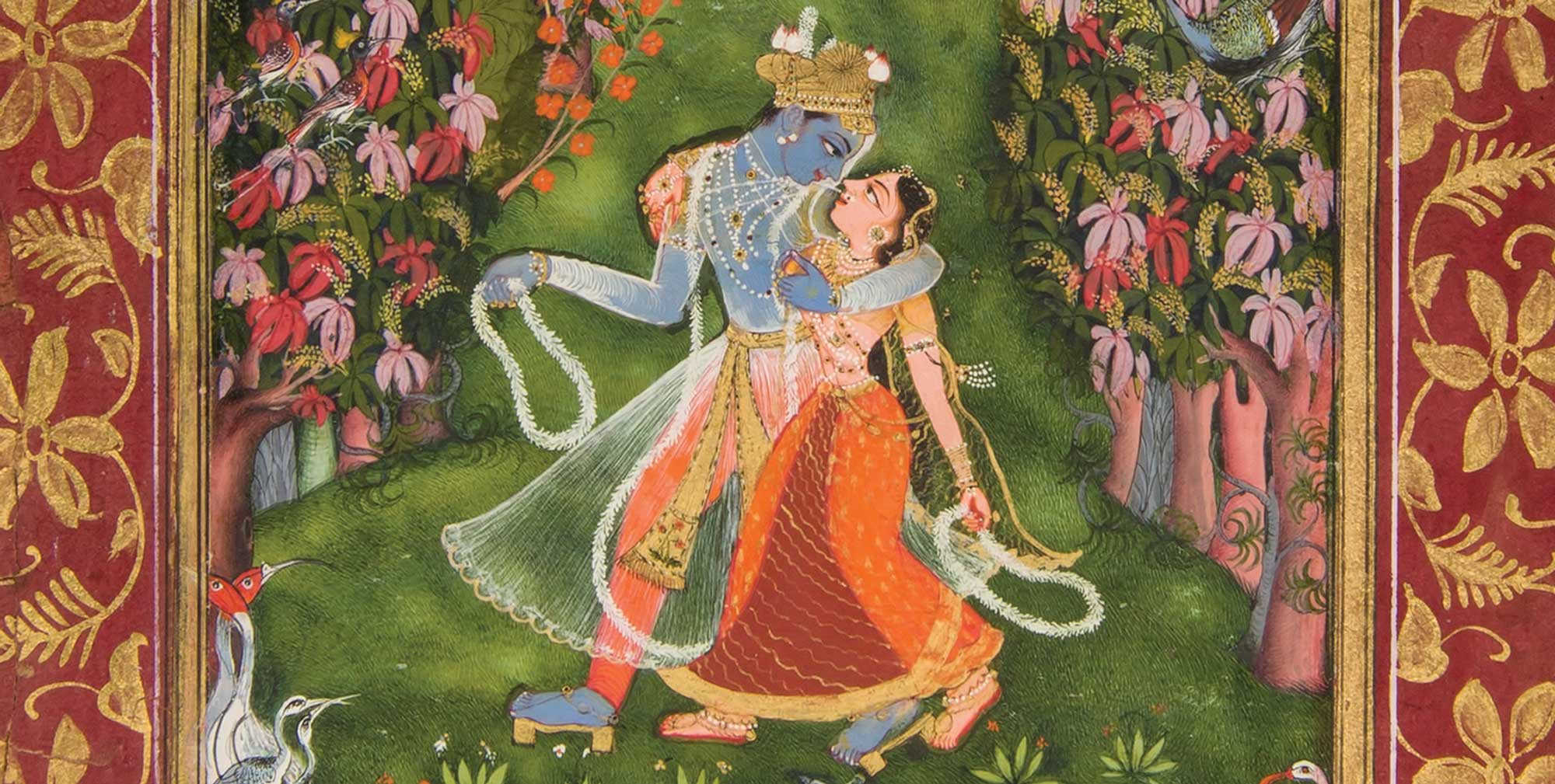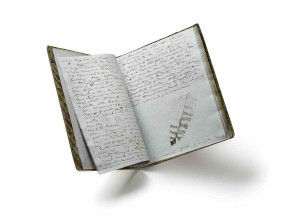Kossow went beyond the staple, overdone focus in this field—color-plate books, lithographs, travel accounts—to identifying and assembling Indian books of bibliographical and typographical importance, several of them in beautiful native bindings. With the tenacity and devotion of the top collectors, he pursued the best possible copies of early printed Indian books from the period 1778 to 1858, many in superlative bindings. “That I can boast of an Indian library,” he told me, “that stands out from its peers for its breadth, interest, rarity, provenance, and condition is simply a matter of consistent application over a very long period of time.”
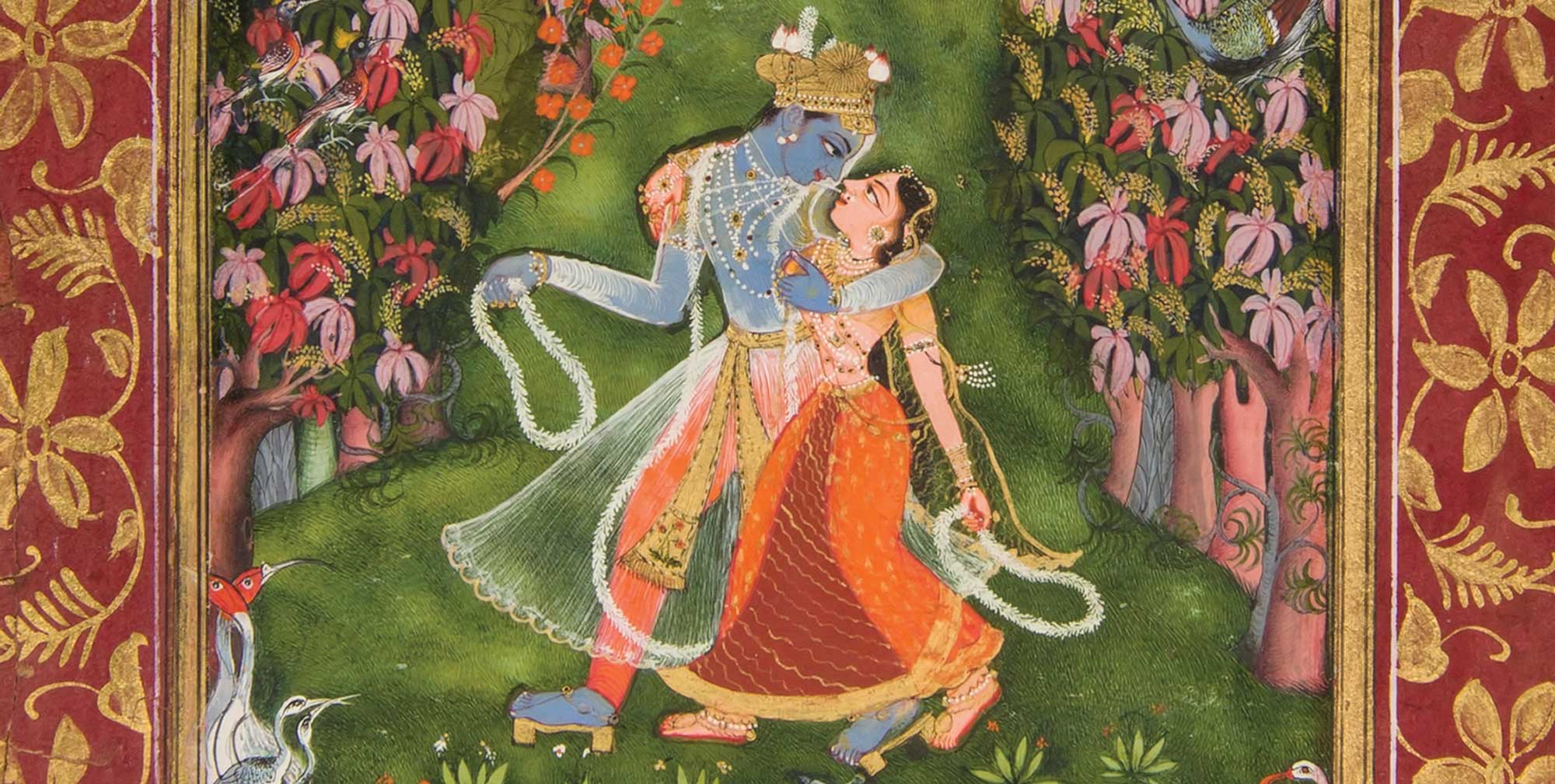
Radha and Krishna Walk in a Flowering Grove, 1720.
The finest collection of rare and early printed books from colonial India is to be found not at the British Library or even within a rare book institution in India, but in a large flat in London, the private library and home of Richard Kossow, a scholarly American collector turned book dealer. For almost half a century he has been a pioneering, impassioned collector of fine and scarce books relating to India, and ‘Indiana’ (as in ‘Americana’) is one of the most difficult fields to collect. The lack of bibliographies, specialist dealers, and serious collectors combined with poorly preserved copies has made putting together a thorough, accomplished collection from the Indian subcontinent a tricky bibliographical challenge.
I should know. As a book collector and a book arts columnist from India, I have spent years trying to identify a collector whose passion, scholarship, and taste was focused on putting together a significant collection of Indiana in their original bindings and in fine state. At first, I thought this could be Glenn Horowitz, the New York–based literary archives broker, who had put together
a charming collection of antiquarian Indian volumes—in fact, it was Kossow who had been instrumental in helping Horowitz find his scarcer Indian material, now acquired by the Lilly Library at Indiana University—but that collection strikes me now as patchy, and it pales before the Kossow collection, which better tells the story of how printing took root in India.

A selection of Kossow’s Indian cloth bindings.
No less than Graham Shaw, the former head of Asia, Pacific & Africa collections at the British Library and one of the most respected book historians of South Asian print history, has said that he has seen nothing like it in all his years of looking at India’s early printed books. “Every time I visit Richard’s library, I have no idea what new wonders I will see. The door opens and your gaze is irresistibly drawn to shelf after shelf … lined neatly with cloth bindings in beautiful condition. The eyes flit hungrily from title to title: Tavernier’s Travels in India in blue, Shakespear’s Wild Sports of India, Allen’s Diary of Sinde and Affghanistan in red with a Pathan marksman at its head, Meadows Taylor’s three-decker novel Seeta distinctive in green, Karaka’s History of the Parsis with Ahura Mazda in gilt, and Herklots’ On the customs of the Moosulmans of India with its twin minarets. Move further in and it gets better.”
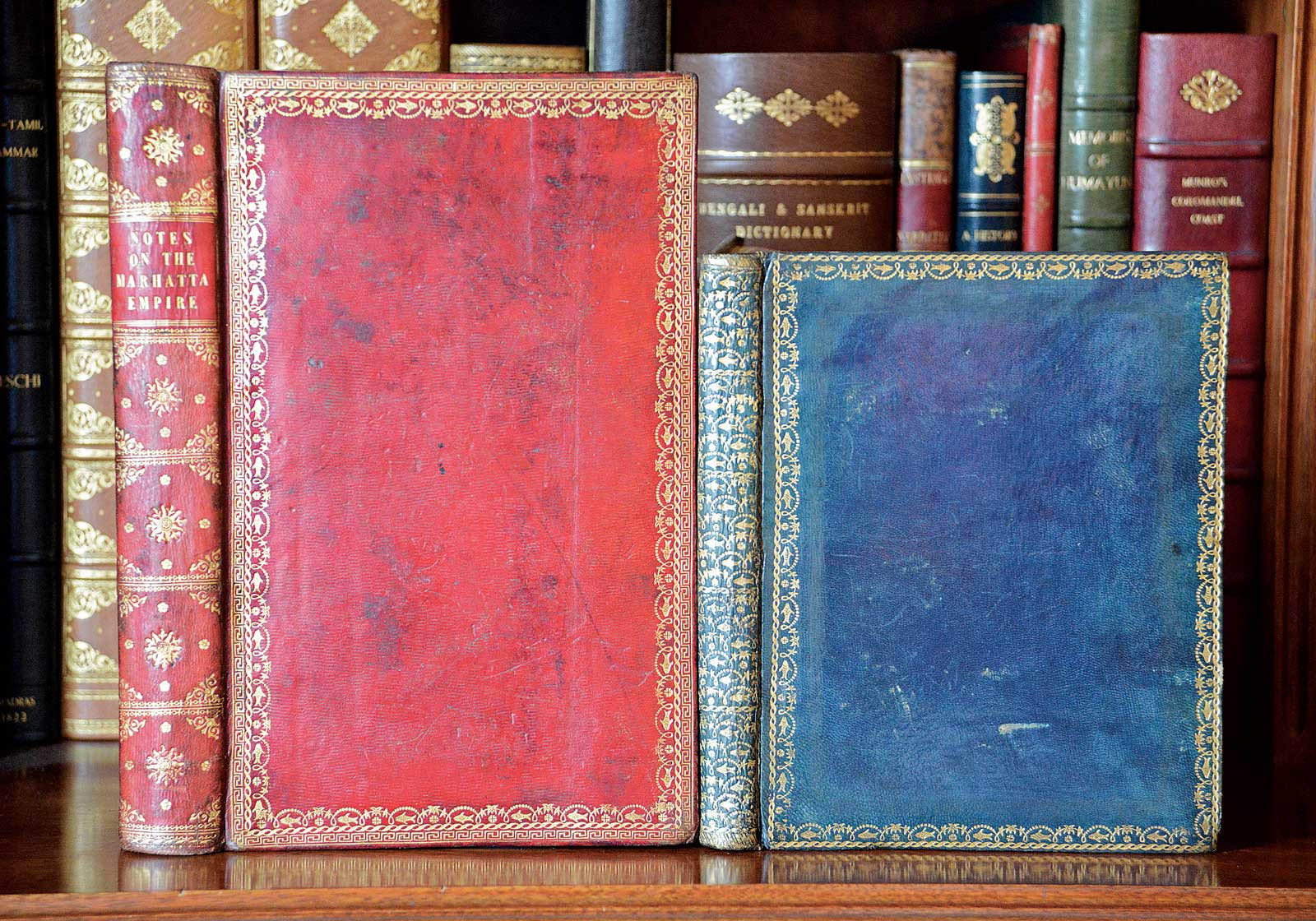
Two examples of the ‘Moghul Fish binder’ goatskin bindings in Kossow’s collection. right: The Tranquebar New Testament in Tamil (1724), the first completely indigenous printing of the New Testament in any Indian language.
Shaw, who is presently working with Kossow on a catalogue of this collection, added, “There will now never be another opportunity to put such a collection together from scratch. The amount of early India-related material becoming available is diminishing all the time, for various reasons. Richard was in the right place, at the right moment, with the right collecting instincts. The collection is unrepeatable.” When completed, the catalogue aims to redefine Indiana collecting, kindle new interest in it, and act as a guide to the next generation of collectors.
By doing a close bibliographical study of these books produced during the time the British East India Company dominated the country, Kossow and Shaw are hoping to throw more light on the extent to which Indians had been involved in the making of these books as printers, designers, binders, typecasters, punchcutters, papermakers, and translators—something that has been shrouded in a kind of bibliographical haze. The British no doubt had supervised and designed these publications, and employed European binders, but several exquisite examples in the Kossow collection appear to be the work of Indian binders. In all probability, these binders came from the same tradition of craftworkers who had once been employed by the Mughal Court to bind medieval Islamic manuscripts in those magnificent, iridescent bindings. “I love them for their colors,” Kossow enthused, “those glowing madder-dyed reds and indigo blues, as well as the more familiar pink-toned reds, which have their origin in Islamic bindings of old, are a feast for the eye.”
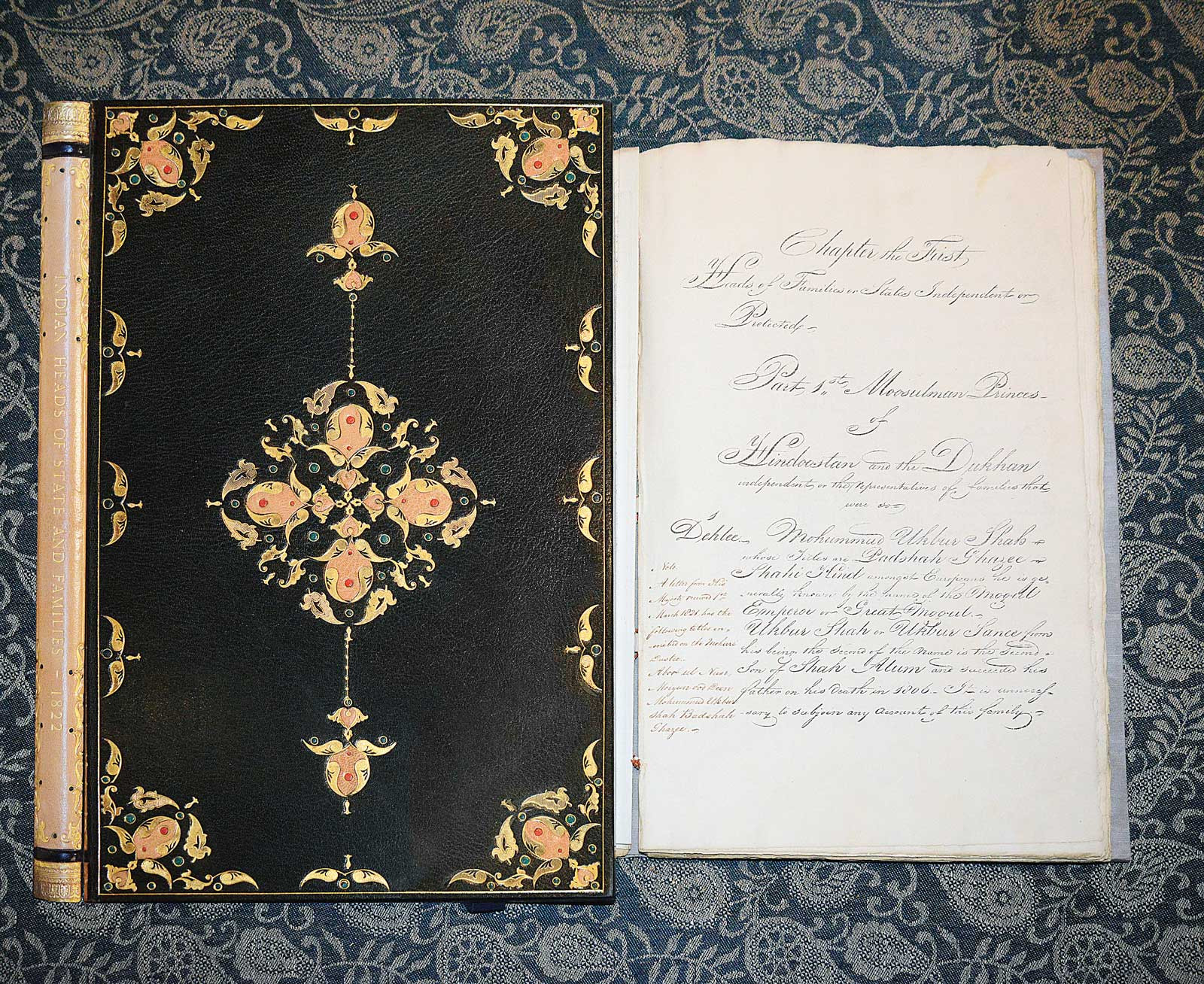
The earliest known lithographic printing from India: a folio, circa 1822, titled Heads of Families in States Independent or Protected. Kossow commissioned a special box from master leather box maker Bill Gardner for it.
After graduating from Yale, Kossow was offered a job in 1969 with a financial firm in London. “This brought me,” he recalled, “to the heart of Europe’s antiquarian book trade. The myriad of old bookshops and auction houses in London were like an Aladdin’s cave of printed treasures.” His Indian journey began at a small bookshop in Kensington. One day, in 1972, he wandered by chance into a bookshop and spotted a substantial quarto with a series of regulations for Indian courts in English and Persian. Printed in Calcutta and dated 1781, the paper and presswork were of exceptional quality. “But at the asking price of £250—and this was in the early ’70s, from which the shop owner wouldn’t budge, I thought it too dear for its content and left it on the shelf.”
He continued, “Not long after this, the lightning bolt of understanding about the importance of early Indian printing finally struck me. I used to travel to Europe often on business, where I usually managed to spend a few joyous hours in the rare book shops of whatever city I was visiting. On one occasion I happened to be in Paris, and a bookseller there produced an extraordinary piece of Indian printing from the Vepery Press in 1779 in a contemporary binding, entitled A Malabar and English Dictionary, wherein the words...of the Tamulian Language...are Explained in English. Just the appearance of the title page, with its Tamil typography and early European design, mesmerized me.”
He bought it, and you can guess what happened next: “When I returned to London, I raced back to that bookshop in Kensington with a pounding heart to see if perchance he still had the Calcutta quarto. He did, and it’s now one of the highlights in my collection.”
Kossow thinks of these early printed books as India’s “Gutenberg experience.” He feels that even though printing from metal type had come to India as early as the sixteenth century through Christian missionaries—first via the Portuguese in Goa and later the Danish in Tranquebar (now Tharangambadi)—the printed book as a means to spread knowledge came into its own in India in the eighteenth century with the British and their interest in translating Indian manuscripts (on law, horticulture, medicine, chess) into English and printing them as pamphlets and books. “I soon came to realize,” he said, “that these books had an excitement that overwhelmed the staid, regimented publications from the later nineteenth-century Indian presses—an excitement of typography, of paper, of binding, and of pioneer efforts to overcome immense difficulties.”
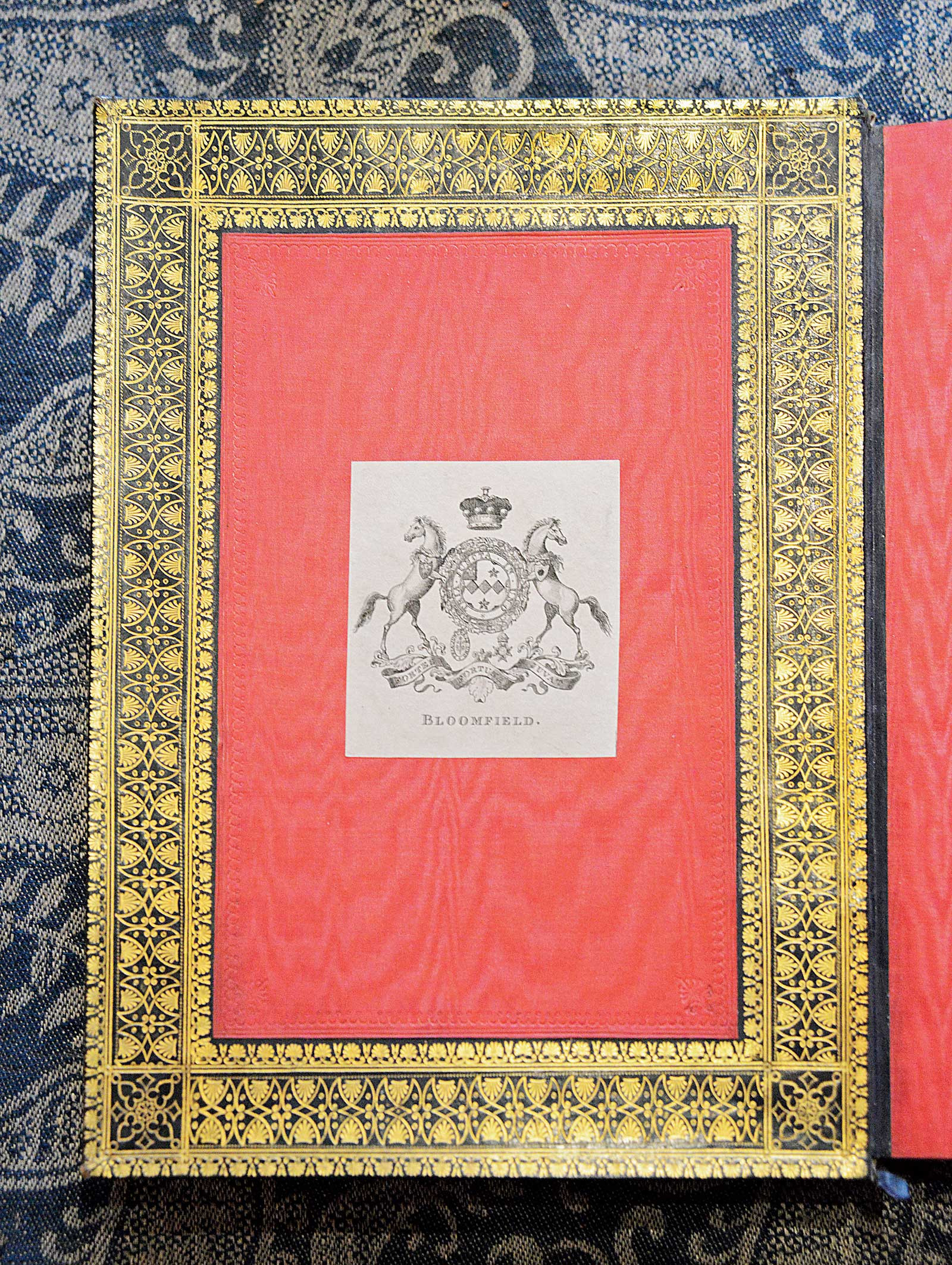
Intricate doublure work inside Whitelaw Ainslie’s Materia Medica of Hindoostan (Madras, 1813). Kossow said this binding: “I have not encountered, in more than fifty years of searching, an Indian imprint which has been accorded more majesty than this example. Everything about its binding, its provenance, its survival says the world—of India and beyond—respects to the highest degree its information and its origin.”
In his collection is a scarce and coveted volume of incunabular printing from India: the Tranquebar New Testament in Tamil from 1724, the first completely indigenous printing of the New Testament in any Indian language. Only seven copies are known to exist, none of them in India. His copy is unrestored and nicely preserved. “I found the book,” he told me, “in a fairly unusual place, and comparatively recently in my book collecting career. It was sitting on the shelves of the travel department of Maggs Bros. Ltd., at their old premises in Berkeley Square, London. Maggs do not hold a large stock of books relating to the Indian subcontinent, but there it was about six or seven years ago, just waiting for me to discover it.”
The book I envy him for owning, though, is the first-ever fine press book from India—or, at least, I like to think of it that way. A Grammar of the Bengal Language, printed at Hoogly in Bengal in 1778 from the first finely designed Indian typeface, is the work of a remarkable English civil servant named Charles Wilkins, who became known as “the Caxton of India.” Kossow’s copy is in its original Indian binding. It is a scarce book but can occasionally be found in specialist catalogues; a copy bound in Britain was listed in 2014 for £6,000. Also in his possession is the first type specimen book issued in India, Specimen of printing types, in use at the Baptist Mission Press, printed in Calcutta in 1826.
The hunt for rare and fine Indian books took Kossow throughout the English countryside, visiting provincial antiquarian book dealers, paying attention to the offerings of regional auction houses, visiting book fairs in a variety of places, and reading booksellers’ catalogues from far and wide. “I could never tell when or where the next gem would become available, but for many years they continued to surface, usually only one at a time.”
One day he came across a truly astonishing volume: a Calcutta imprint from 1794 in mint condition, bound in a lustrous indigo-blue Indian goatskin binding, with gilt roll tooling around the covers and the entirety of the flat spine consisting of repeated fish and flowers. It was stunning and clearly contemporary with the book’s printing. “I dubbed this unknown binding maestro the ‘Moghul Fish’ binder, as his fish reminded me of the royal insignia used by the rulers of Oude. Years later I found other books bound by the Moghul Fish binder in the same style and books with copies of his distinctive roll tool used on Indian bindings in a more European style.”

Richard Kossow with his book collection.
Of the seven rooms in the Kossow household, all but one are filled to overflowing with specially designed bookcases, several of which are brimming with books on India, every one of them in the best condition copy Kossow could acquire. Most of these are protected by custom-made slipcases or clamshell boxes, and even those are impressive. For example, he commissioned a box to hold a tall folio, the earliest known example of lithographic printing in India titled Heads of Families in States Independent or Protected. The box and its inlays were created by Bill Gardner, a master leather box maker, and the gilding was applied by a specialist from the famous fine binders, Sangorski & Sutcliffe. “You can see,” Kossow pointed out, “I put as much time, effort, and expense into the display and preservation of early books on India as I do in obtaining the books themselves.”
What he has uncovered, Kossow emphasized, is only the first few layers of what one can glean of India’s early printing. There is so much we don’t know yet, he added, about the role of Indians in the bibliophilic endeavors of the British in India. While his own collection can serve as a basis for further research, he feels other collectors should jump in, so a fuller picture can emerge from multiple collections. “This has been a fulfilling journey for almost half a century. I hope that others will feel the way I do about these books and keep on the lookout for worthy additions.”
From the months I spent getting to know Kossow and his collection, one factor rose above all others in indicating why, when other collectors took only a passing fancy to colonial Indian books, he spent forty-five years forming a non-pareil library: he truly respects and loves them. From the first time he laid eyes on that piece of startling Vepery printing in Paris, he felt an immediate and deep affinity for these lovely, if neglected, books from India.

